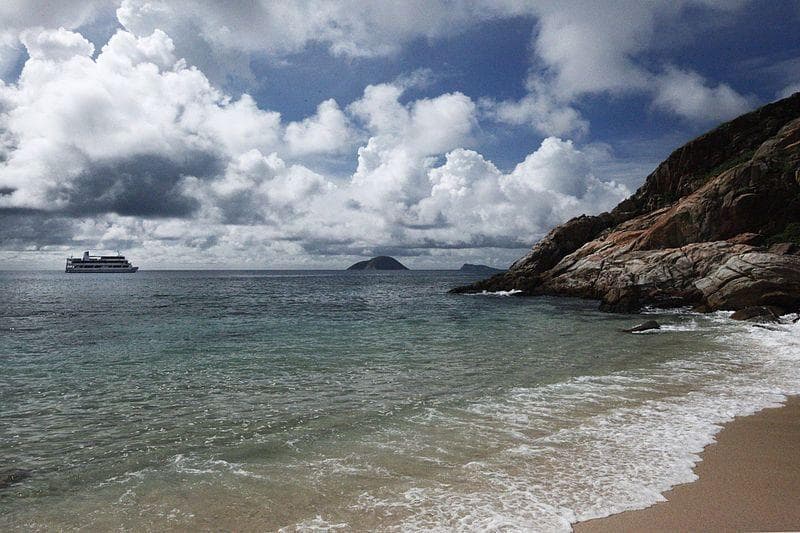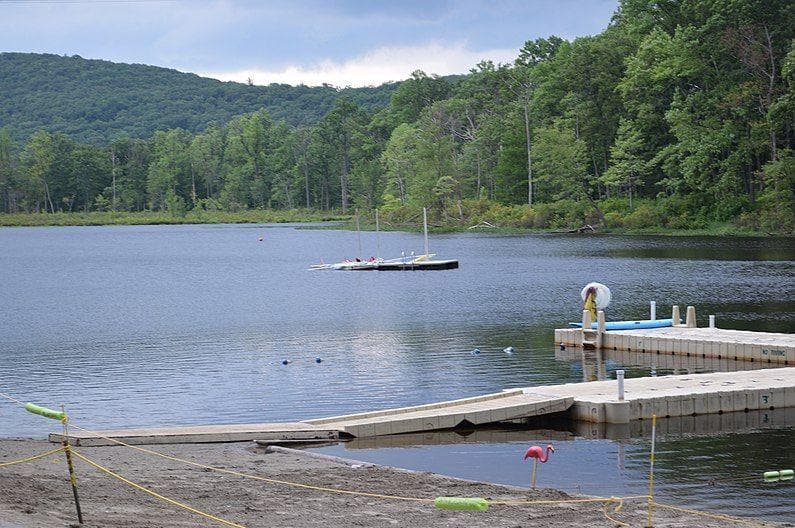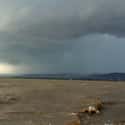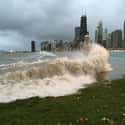-
(#1) Baltic Sea
- Sea
As part of the 1945 Potsdam Agreement, Allied forces took weapons away from Germany and dumped them into the Baltic Sea so no one could get their hands on them. Back then, no one apparently thought it was an issue to litter the sea with 65,000 tons of potenitally hazardous material. In 2013, scientists discovered that the sea bed off the coast of Poland contained trace amounts of mustard gas, meaning the hazardous material may finally be returning.
Researchers are not only concerned that the weapons are leaking, but they've also discovered hazardous materials in places where they shouldn't be. This means scientists have no idea exactly where the dangerous weapons are, and it will be that much harder to clean them up. Considering that the leaks taint the water and fish, thus contaminating the food chain, the forgotten WWII relics could pose a grave danger to the environment and anything, or anybody, in the water.
-
(#2) Black Sea
- Sea
As a major tourist destination between Asia and Eastern Europe, millions of people visit the beaches, resorts, and islands of the Black Sea each year. The sea's surface may inspire many an Instagram photo, but beneath the surface water lies an area much creepier. The Black Sea is a meromictic body of water, which means it features separate layers of water that do not mix together.
While the water on the surface is friendly to visitors, the layer of water below it is completely devoid of oxygen. Nothing can survive in this zone, and creatures or ships that fall into the area take a long time to decompose. Shipwrecks and the remains of those who have drowned may still be seen hundreds of years after sinking. This gave rise to rumors and stories that the Black Sea is home to the deceased who lurk in its deep waters. When you really think about it, who wants to swim in that?
-
(#3) Dead Sea
- Lake
Nestled between Israel, Jordan, and the West Bank, the Dead Sea is popular with tourists due to the lack of sharks and the high concentration of salt in its water, which allows swimmers to easily float. This unique feature has also led to stories that it's impossible to drown in its waters, but this is unfortunately not true. While swimmers floating on their backs may enjoy the buoyancy, if someone decides to swim facedown or trips and lands in the water face first, it could be dangerous.
Containing 10 times more salt than the ocean, the water of the Dead Sea is extremely dense. This is what allows people and objects to float, but it also hinders them from being able to maneuver in the water. People who wind up facedown will struggle to right themselves as the dense water won't allow them to move their lower body downward. It's also possible for swimmers to accidentally swallow some of the highly salty water, which could disrupt their balance of electrolytes, hurt their organs, and essentially poison them. Needing rescue from the Dead Sea is unfortunately relatively common, and lifeguards rescued 21 people from drowning in 2010 alone.
-
(#4) Gulf of Mexico
- Gulf
The warm waters of the Gulf of Mexico bring tourists and beach-goers to its shores every year, but little do they know that they might be swimming with flesh-eating bacteria. Because the water is warm and increases in temperature slightly each year due to global warming, bacteria like Vibrio vulnificus and Group A streptococcus have less difficulty growing. These bacteria and others thrive in the salty, warm water and tend to gather where rivers enter the gulf.
They infect people after being consumed in raw shellfish, and can also use open wounds to enter the bodies of those who take a dip in the water. Once inside, the bacteria can cause necrotizing fasciitis, which infects and destroys tissues, including skin and internal organs. Infected people may have less than 72 hours to get treatment, which can include antibiotics, surgery, or possibly amputation before the condition becomes fatal. Don't cancel your trip to the beach just yet, though. While flesh-eating bacteria makes headlines and can induce nightmares, necrotizing fasciitis is actually pretty rare.
-
(#5) Lake Victoria
- Lake
With around 5,000 people drowning in its waters each year, the high number of casualties puts Lake Victoria at the top of the most dangerous list. Located in Kenya, Uganda, and Tanzania, it's the second largest body of fresh water in the world and provides water to the Nile River, as well as business for local fishermen. However, those fishermen, and whoever else ventures into Lake Victoria by boat, could be in danger. Weather changes frequently on the lake and unexpected rough water with high waves can destroy small boats, capsize ships, and claim the lives of those who fall in. When ferry boats crossing the lake overturn, hundreds of people can perish.
Boaters can't tell the depth of the lake at any given location and rocks lie just below the surface in many areas. Dangerous weather can also make communication with people on land difficult, meaning those who find themselves in trouble on the water may not receive help in time. For those who fall in but manage to survive, the vastness of Lake Victoria can confuse swimmers who may not know the direction to shore or exactly how far they must swim.
-
(#6) Brighton Beach
- Neighborhood
In 2018, 16 million people visited New York City beaches including Brighton Beach, and many of those people may have come into contact with fecal contamination. The water that oblivious swimmers doggy-paddled through was often combined with water from the city's sewer. This can happen when rain water enters the sewer, combines with sewage to create more material than pipes are designed to hold, and then enters the waterways as the sewer overflows. Contamination also comes from the land, as rain carries trash, pet waste, and other polluted materials into the ocean through runoff.
According to 2018 records, this gross process happened every three days that year. Luckily, authorities monitor the city's beaches consistently and will post warnings if the water is unsafe. Finding a day that is safe, however, is growing increasingly difficult, as 276 of the 422 tested beaches reached an unsafe level at least once that year.
-
(#7) Lake Tahoe
- Lake
A 2015 blog post by the US Coast Guard told the story of a man who went stand-up paddleboarding in Lake Tahoe, fell into the water after losing his balance, and never resurfaced. Since he didn't hit his head, authorities believed he suffered from cold water immersion - a fatal process which is unfortunately all too common in the cold waters of Lake Tahoe. Its surface water averages about 60 degrees in summer, and although that wouldn't be considered cold as an air temperature, a water temperature of less than 70 degrees can be dangerous.
Cold water can certainly cause hypothermia, but drownings in Lake Tahoe are instead mostly caused by cold water shock. When people enter cold water suddenly, such as falling into the lake, they reflexively gasp, allow water to enter their lungs, and choke. As they sink farther into colder water unable to breathe, their movements become impaired by the water temperature and they drown. Authorities urge people engaging in water sports to wear life jackets at all times, but unfortunately, about seven people drown every year after entering cold water and going into shock.
-
(#8) Potomac River
- River
Once visitors and locals tire of city life in Washington, DC, they may escape to an area of the Potomac River between Great Falls and the border of Maryland known as the Potomac River Gorge. While the area is scenic and filled with beautiful waterfalls, the water is extremely dangerous. It's so dangerous, in fact, it's illegal to swim in this part of the river, and people wanting to kayak must be approved by the State of Maryland and sign a release.
Although the water looks calm in areas, incredibly strong currents lie below and can drag people underwater. Rocks and broken trees can also lurk below the surface and may be hard to see when the river's water is murky. Despite warnings and laws, a few people perish in the river each year, including five in 2003 and six in 2009. Discouraging swimmers has become such an important mission for the Potomac River Safety Task Force that their messages include the stern warning, "If you enter the river, you will die."
-
(#9) Lake Michigan
- Lake
Although Lake Michigan isn't the largest of the Great Lakes, it is the most dangerous. In addition to water temperatures that could cause hypothermia and strong winds that create dangerously powerful waves, the lake's structure causes a problem that's even more dangerous: rip and longshore currents. Because Lake Michigan is longer than it is wide and runs north to south without any major obstacles along its shores, winds blowing perpendicular to the shore create rip currents, while those blowing parallel can form longshore currents.
These currents aren't always noticeable to swimmers but can carry them far from where they intended to be. As rip currents bounce off the shore and transport water back into the lake, they can carry swimmers with them and can be so powerful that swimmers may find it very difficult to escape. Lake Michigan is so notorious for these dangerous currents that swimmer fatalities and rescues from its waters generally account for about half of all such instances on all the Great Lakes combined. From 2002 to 2015, 243 swimmers were rescued and 82 people drowned, and these numbers unfortunately continue to grow. From January to August of 2019, drownings in Lake Michigan saw an 80% increase from the previous year.
-
(#10) Caribbean Sea
- Sea
Although lionfish live mostly in the Indo-Pacific, they've managed to create homes in other warm areas around the world. Since they have no known predators, their populations have flourished. People can easily find these spiny fish in the Caribbean Sea, and researchers believe they bred from pets released into the wild or hitched a ride on boats. However they managed to travel, lionfish are now considered an invasive species and people in the Caribbean have been trying to diminish their numbers.
While lionfish are definitely a problem for the health of the Caribbean and its native residents, they can also be a problem for divers, snorkelers, and swimmers. The 18 thin dorsal fins the lionfish displays are stingers they use for self-defense, and those unfortunate enough to come into contact with one will not easily forget it. Although the lionfish's venom isn't strong enough to seriously harm a healthy human, the sting causes extreme pain. The venom can also cause breathing difficulties and nausea, which can be a drag but can also make swimming back to land difficult.
-
(#11) Lake Pontchartrain
- Body Of Water
Bull sharks tend to hang out along coastlines also popular with swimmers, and they are considered the world's most dangerous sharks, as well as one of the most likely to attack humans. They are usually more curious than hungry, however, but they have attacked people at least 69 times throughout history. Because they can thrive out of salt water, their numbers aren't limited to the ocean, and bull sharks have been found swimming in the Amazon River, the Mississippi River, and even Louisiana's Lake Pontchartrain.
Authorities counted at least 25 sharks in the lake as of 2016 and assumed they hang out in the lake during summer months to avoid predators. They claim that the hottest gathering spots for the sharks are around popular beaches near Goose Point and Seabrook, and since they hang around during the warm months when people are most likely to swim or engage in water activities, that makes encounters between shark and man more likely. Luckily, bull shark attacks in Lake Pontchartrain are still extremely rare.
-
(#12) Long Beach
- Place
California's Los Angeles County has plenty of options for beach-goers, but depending on the weather and time of year, they may want to rethink their visit. Many beaches harbor poor water quality, but in 2019, Heal the Bay discovered that Long Beach was the worst offender. Tests revealed dangerous bacteria and E. coli in the water, which could potentially cause diarrhea, vomiting, and stomach cramps in swimmers. For those with unhealthy immune systems, the elderly, or small children, E. coli can be dangerous enough to end lives.
The time of year affects whether or not swimmers can safely enter the water, however, and the winter months tend to be worse. More rain means there's more runoff from urban areas and storm drains that flow into the ocean, and the fecal matter and other nasty materials from this runoff may contain dangerous bacteria. In the case of Long Beach, runoff enters the Los Angeles River, which carries the potentially dangerous contamination into the ocean as it empties. Beach lovers can rejoice, however, that when the weather is drier in summer, the danger is much less severe.
New Random Displays Display All By Ranking
About This Tool
71% of the earth is covered by water. Oceans, lakes, and rivers are important resources for human beings to survive. The locations where these bodies of water are concentrated are also places where people like to go on vacation. Attracted by the beautiful blue or peaceful bodies of water, many people like to jump into the natural pool, but don't be fooled by appearances. Nature is not always a safe place.
There are strange, deadly, beautiful, and unusual mysterious bodies of water on the earth. We must know that many aggressive and deadly marine life also lives in these places, and rapid is also one of the unforeseen dangerous accidents. There are random 12 famous bodies of water with some dark secrets.
Our data comes from Ranker, If you want to participate in the ranking of items displayed on this page, please click here.





















